Dynamic programming (dp) in Algorithm
- 2. Dynamic Programming is a general algorithm design technique for solving problems defined by recurrences with overlapping subproblems •Invented by American mathematician Richard Bellman in the 1950s to solve optimization problems and later assimilated by CS •“Programming” here means “planning” •Main idea: - set up a recurrence relating a solution to a larger instance to solutions of some smaller instances - solve smaller instances once - record solutions in a table - extract solution to the initial instance from that table Dynamic Programming (DP)
- 3. • Two key ingredients for an optimization problem to be suitable for a dynamic-programming solution: Each substructure is optimal. (Principle of optimality) 1. optimal substructures 2. overlapping subproblems Subproblems are dependent. (otherwise, a divide-and- conquer approach is the choice.)
- 4. – The recurrence relation (for defining the value of an optimal solution); – The tabular computation (for computing the value of an optimal solution); – The traceback (for delivering an optimal solution). The development of a dynamic-programming algorithm has three basic components:
- 5. Some exemple for DP • Coin Change • 0/1 Knapsack • LCS , Etc.
- 6. Problem Set Of Coins = { 8 , 5 , 1} Make Change Of Taka, n =10 Exemple for Coin Change
- 7. T[i]=min[T[i],1+T[i-coin[j]]] Solution j c o i n [ j ] 0 8 1 5 2 1 1 2 3 4 5 6 7 8 9 10 1 2 3 4 1 2 3 1 2 2 1 2 3 4 5 6 7 8 9 10 2 2 2 2 1 2 2 0 2 1 10 - 5 = 5 - 5 = 0 5+5=10
- 8. Problem : n = 4 S = 5 Elements (size,value)= {(2,3),(3,4),(4,5),(5,6 Need = 7 Exemple for 0/1 Knapsack
- 9. is 0 1 2 3 4 5 0 1 2 3 4 Here , max item = 4 max size = 5 Solution
- 10. is 0 1 2 3 4 5 0 0 0 0 0 0 0 1 0 2 0 3 0 4 0 For s = 0 to s For i = 0 to n V[0,s] = 0 V[i,0] = 0
- 11. is 0 1 2 3 4 5 0 0 0 0 0 0 0 1 0 0 2 0 3 0 4 0 Item (Si,Vi ) 1 (2,3) 2 (3,4) 3 (4,5) 4 (5,6) If Si<=S if Vi+V[i-1,S-Si]>V[i-1,S] V[I,s]=Vi+V[i-1,S-Si] else V[I,s]=V[i-1,S] Else V[I,S]=V[i-1,S]
- 12. is 0 1 2 3 4 5 0 0 0 0 0 0 0 1 0 0 3 3 3 3 2 0 0 3 4 4 7 3 0 0 3 4 5 7 4 0 0 3 4 5 7
- 13. is 0 1 2 3 4 5 0 0 0 0 0 0 0 1 0 0 3 3 3 3 2 0 0 3 4 4 7 3 0 0 3 4 5 7 4 0 0 3 4 5 7 Item (Si,Vi ) 1 (2,3) 2 (3,4) 3 (4,5) 4 (5,6) i=n,k=S while i,k > 0 if V[I,k]=V[1-i,k] I = i-1, k = k-Si else i = i-1
- 14. is 0 1 2 3 4 5 0 0 0 0 0 00 1 0 0 3 3 33 2 0 0 3 4 4 7 3 0 0 3 4 5 7 4 0 0 3 4 5 7 The optimal knapsack should contain {1,2} = 7 Item (Si,Vi ) 1 (2,3) 2 (3,4) 3 (4,5) 4 (5,6)
- 15. Problem X = {A, B, C, B, D, A, B} Y = {B, D, C, A, B, A} Exemple for LCS
- 16. SOLUTION 0 if i = 0 or j = 0 c[i-1, j-1] + 1 if xi = yj max(c[i, j-1], c[i-1, j]) if xi yj 0 1 2 3 4 5 6 yj B D C A B A 0 0 0 0 0 0 0 0 0 0 0 1 1 1 0 1 1 1 1 2 2 0 1 1 2 2 2 2 0 1 1 2 2 3 3 0 1 2 2 2 3 3 0 1 2 2 3 3 4 0 1 2 2 3 4 4 If xi = yj b[i, j] = “ ” Else if 1 xi 2 A c[i - 1, j] ≥ c[i, j-1] 2 B 3 C 4 B 5 D 6 A 7 B b[i, j] = “ ” else b[i, j] = “ ” c[i, j] =
- 17. • Start at b[m, n] and follow the arrows • When we encounter a “ “ in b[i, j] xi = yj is an element of the LCS 1 xi 2 A 3 B 4 C 5 B 6 D 7 A 8 B 0 1 2 3 4 5 6 yj B D C A B A 0 0 0 0 0 0 0 0 0 0 0 0 0 0 0 1 1 1 1 1 1 0 1 1 1 2 2 2 0 1 2 2 2 2 2 1 1 2 2 2 3 3 1 2 2 3 3 3 4 1 2 2 3 3 4 4 Longest common subsequence is {A,B,C,B}

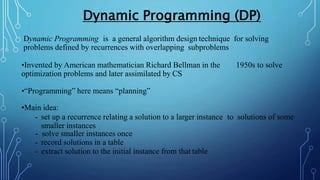
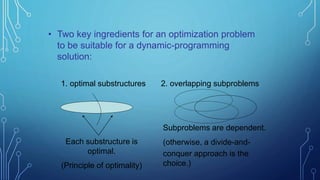
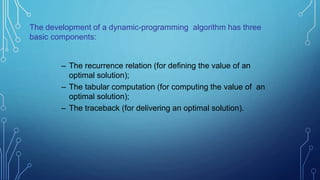
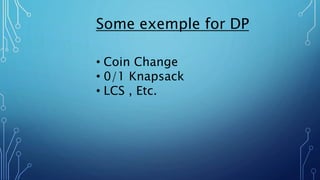

![T[i]=min[T[i],1+T[i-coin[j]]]
Solution
j c o i n [ j ]
0 8
1 5
2 1
1 2 3 4 5 6 7 8 9 10
1 2 3 4 1 2 3 1 2 2
1 2 3 4 5 6 7 8 9 10
2 2 2 2 1 2 2 0 2 1
10 - 5 = 5 - 5 = 0 5+5=10](https://image.slidesharecdn.com/dynamicprogrammingdp-190909141856/85/Dynamic-programming-dp-in-Algorithm-7-320.jpg)
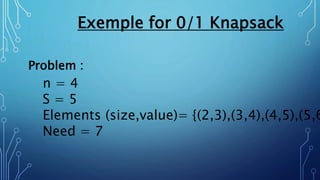

![is 0 1 2 3 4 5
0 0 0 0 0 0 0
1 0
2 0
3 0
4 0
For s = 0 to s For i = 0
to n
V[0,s] = 0 V[i,0] =
0](https://image.slidesharecdn.com/dynamicprogrammingdp-190909141856/85/Dynamic-programming-dp-in-Algorithm-10-320.jpg)
![is 0 1 2 3 4 5
0 0 0 0 0 0 0
1 0 0
2 0
3 0
4 0
Item (Si,Vi
)
1 (2,3)
2 (3,4)
3 (4,5)
4 (5,6)
If Si<=S
if Vi+V[i-1,S-Si]>V[i-1,S]
V[I,s]=Vi+V[i-1,S-Si]
else
V[I,s]=V[i-1,S]
Else V[I,S]=V[i-1,S]](https://image.slidesharecdn.com/dynamicprogrammingdp-190909141856/85/Dynamic-programming-dp-in-Algorithm-11-320.jpg)

![is 0 1 2 3 4 5
0 0 0 0 0 0 0
1 0 0 3 3 3 3
2 0 0 3 4 4 7
3 0 0 3 4 5 7
4 0 0 3 4 5 7
Item (Si,Vi
)
1 (2,3)
2 (3,4)
3 (4,5)
4 (5,6)
i=n,k=S
while i,k > 0
if V[I,k]=V[1-i,k]
I = i-1, k = k-Si
else
i = i-1](https://image.slidesharecdn.com/dynamicprogrammingdp-190909141856/85/Dynamic-programming-dp-in-Algorithm-13-320.jpg)


![SOLUTION
0 if i = 0 or j = 0
c[i-1, j-1] + 1 if xi = yj
max(c[i, j-1], c[i-1, j]) if xi yj
0 1 2 3 4 5 6
yj B D C A B A
0 0 0 0 0 0 0
0
0
0
0 1 1 1
0 1 1 1
1 2 2
0
1
1 2 2
2
2
0 1
1
2
2 3 3
0
1 2
2
2
3
3
0
1
2
2 3
3 4
0 1
2
2
3 4
4
If xi = yj
b[i, j] = “ ”
Else if
1 xi
2 A
c[i - 1, j] ≥ c[i, j-1] 2 B
3 C
4 B
5 D
6 A
7 B
b[i, j] = “ ”
else
b[i, j] = “ ”
c[i, j] =](https://image.slidesharecdn.com/dynamicprogrammingdp-190909141856/85/Dynamic-programming-dp-in-Algorithm-16-320.jpg)
![• Start at b[m, n] and follow the arrows
• When we encounter a “ “ in b[i, j] xi = yj is an element
of the LCS
1 xi
2 A
3 B
4 C
5 B
6 D
7 A
8 B
0 1 2 3 4 5 6
yj B D C A B A
0 0 0 0 0 0 0
0
0
0
0
0
0
0
0
1
1
1
1
1
1
0
1
1
1
2
2
2
0
1
2
2
2
2
2
1
1
2
2
2
3
3
1
2
2
3
3
3
4
1
2
2
3
3
4
4
Longest common subsequence is {A,B,C,B}](https://image.slidesharecdn.com/dynamicprogrammingdp-190909141856/85/Dynamic-programming-dp-in-Algorithm-17-320.jpg)
